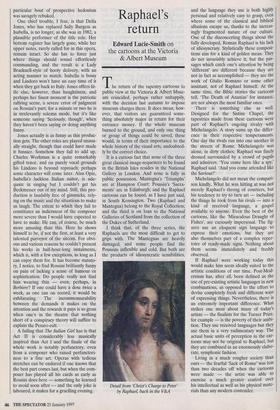Raphael's return
Edward Lucie-Smith on the cartoons at the Victoria & Albert Museum The return of the tapestry cartoons to public view at the Victoria & Albert Muse- um coincided, perhaps rather unhappily, with the decision last autumn to impose museum charges there. It does mean, how- ever, that visitors are guaranteed some- thing absolutely major in return for their entrance money. If the whole museum burned to the ground, and only one thing or group of things could be saved, these would, in terms of their importance to the whole history of the visual arts, undoubted- ly be the correct choice.
It is a curious fact that none of the three great classical image-sequences to be found in the British Isles resides in the National Gallery in London. And none is fully in public possession. Mantegna's 'Triumphs' are at Hampton Court; Poussin's 'Sacra- ments' are in Edinburgh; and the Raphael cartoons can be found, as I have just said, in South Kensington. Two (Raphael and Mantegna) belong to the Royal Collection; and the third is on loan to the National Galleries of Scotland from the collection of the Dukes of Sutherland.
I think that, of the three series, the Raphaels are the most difficult to get to grips with. The Mantegnas are heavily damaged, and some people find the Poussins inflexible and cold. But both are the products of idiosyncratic sensibilities, Detail from 'Christ's Charge to Peter' by Raphael, back in the V&A and the language they use is both highly personal and relatively easy to grasp, even where some of the classical and biblical allusions escape us, thanks to the increas- ingly fragmented nature of our culture. One of the disconcerting things about the fully developed, Roman Raphael is his lack of idiosyncrasy. Stylistically these composi- tions aim for a kind of golden mean. They do not invariably achieve it, but the pas- sages which catch one's attention by being `different' are different because they are not in fact as accomplished — they are the work of Giulio Romano or some other assistant, not of Raphael himself. At the same time, the Bible stories the cartoons tell, 'The Death of Ananias' for instance, are not always the most familiar ones.
There is something else as well. Designed for the Sistine Chapel, the tapestries made from these cartoons were part of Raphael's ongoing rivalry with Michelangelo. A story sums up the differ- ence in their respective temperaments. One day the rivals ran into one another in the streets of Rome. Michelangelo was alone, in dirty clothes; Raphael was finely dressed surrounded by a crowd of pupils and admirers. 'You come here like a spy,' Raphael said. 'And you come attended like the Saviour!'
Michelangelo did not mean the compari- son kindly. What he was hitting at was not merely Raphael's throng of courtiers, but his tendency to try to turn art — including the things he took from his rivals — into a kind of received language, a gospel available to anyone. Even the best of the cartoons, like the 'Miraculous Draught of Fishes', are curiously impersonal. The fig- ures use an eloquent sign language to express their emotions, but they are also themselves part of a complex reper- toire of ready-made signs. Nothing about them seems immediately and freshly observed.
If Raphael were working today this would make him seem ideally suited to the artistic conditions of our time. Post-Mod- ernism has, after all, been defined as the use of pre-existing artistic languages in new combinations, as opposed to the effort to devise completely fresh and different ways of expressing things. Nevertheless, there is an extremely important difference, What strikes one most about many of today's artists — the finalists for the Turner Prize, for example — is the poverty of their ambi- tion. They use received languages but they use them in a very rudimentary way. The actual basic units of perception in the car- toons may not be original to Raphael, but they are combined in an enormously elabo- rate, symphonic fashion.
Living in a much rougher society than ours — the fearful 'Sack of Rome' was less than two decades off when the cartoons were made — the artist was able to exercise a much greater control over his intellectual as well as his physical mate- rials than any modern contender.


































































 Previous page
Previous page